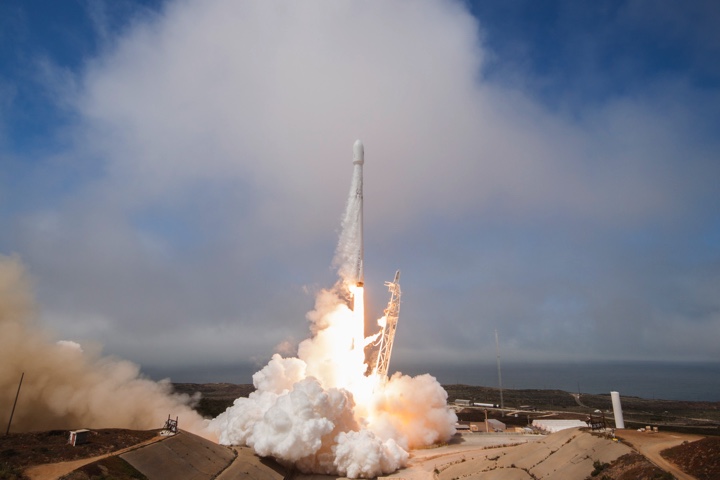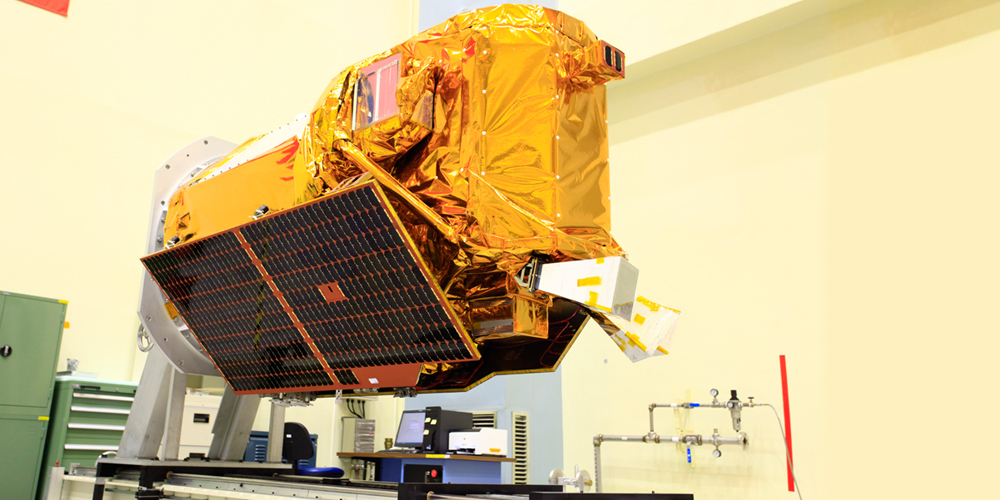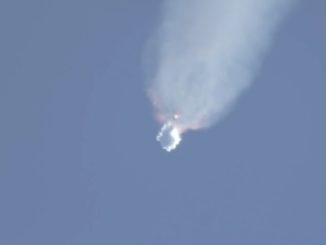
- The Falcon 9 rocket lifts off Thursday with Formosat 5. Credit: SpaceX
Flying with an exceptionally lightweight payload, a Falcon 9 rocket delivered a multipurpose research satellite into a nearly 450-mile-high orbit Thursday for Taiwan following a smooth countdown and liftoff from California’s Central Coast.
Weighing in at about a half-ton, or 475 kilograms, the Formosat 5 satellite doubles as an orbiting observatory to look down on Earth and as a pathfinder for Taiwan’s future space ambitions.
Formosat 5 climbed into space aboard a SpaceX Falcon 9 rocket, which lifted off at 11:51 a.m. PDT (2:51 p.m. EDT; 1851 GMT) from Vandenberg Air Force Base, California.
Originally slated to fly on SpaceX’s discontinued Falcon 1 rocket, Formosat 5 is the first major space mission fully designed, manufactured and tested in Taiwan. It follows Formosat 2, a European-built satellite owned by Taiwan’s National Space Organization, or NSPO, launched in 2004 from Vandenberg on a Taurus rocket.
Formosat 2 was retired last year, well after Formosat 5 was originally scheduled for launch. But the project ran into delays in Taiwan, and Formosat 5’s launch was switched to a larger Falcon 9 rocket once SpaceX ended its Falcon 1 rocket program.
Two SpaceX rocket mishaps over the last two years also contributed to the delays.
But the pre-launch worries faded Thursday with an on-target launch directly into Formosat 5’s planned operating perch around 450 miles (720 kilometers) above Earth. Formosat 5 will fly in a sun-synchronous orbit, allowing its camera to regularly take photos of locations around the world, supporting scientific research and disaster monitoring functions.
The 229-foot-tall (70-meter) Falcon 9 rocket soared through low clouds a few seconds after liftoff, then turned south on course to place its payload into an orbit flying over Earth’s poles.
The first stage of the Falcon 9 switched off its nine Merlin engines around two-and-a-half minutes into the mission, then detached 60 miles (100 kilometers) over the Pacific Ocean to begin a ballistic plummet toward a remotely-controlled floating barge.
Meanwhile, the upper stage’s single Merlin engine fired six-and-a-half minutes to send Formosat 5 into orbit. About a minute after the Falcon 9 and Formosat 5 arrived in orbit, the first stage touched down on its landing target, making a propulsive vertical descent before settling on the platform with the aid of four deployable legs.
Moments later, Formosat 5 flew free from the Falcon 9’s upper stage. Live video from a camera mounted on the rocket showed the Taiwanese satellite receding from view.
The NSPO said ground controllers received the first radio signals from Formosat 5 via a ground station in Svalbard, Norway, around 83 minutes after liftoff, confirming the craft’s condition and health.
The Falcon 9’s upper stage was programmed to reignite its engine later Thursday for a de-orbit maneuver to burn up in the atmosphere over the Pacific Ocean.
SpaceX and Formosat 5’s owner declared success, making the Falcon 9 booster 12-for-12 this year after returning to service in the wake of an on-pad rocket explosion last year. Thursday’s launch also marked the 40th Falcon 9 flight overall since SpaceX debuted the first version of the launcher in June 2010.
The first stage on Thursday’s launch, a newly-manufactured booster, will return to port in Southern California in a few days for inspections, refurbishment and potential reuse on a future mission.
Thursday’s flight was the fifth time a Falcon 9 rocket has launched from Vandenberg’s Space Launch Complex 4-East, a hillside launch complex previously used by heavy-lift Titan 4 rockets.
The Air Force’s Western Range manages tracking and support infrastructure at Vandenberg.
“The Falcon 9 launch of Formosat 5 was an incredible mission to be a part of,” said Capt. Kylie Pracher, Air Force launch commander for the Formosat 5 mission from the 1st Air and Space Test Squadron. “This was the first satellite manufactured and integrated entirely by Taiwan and it was also the fastest turnaround time between Falcon launches here at Space Launch Complex 4. Our Air Force team put in a lot of work to support the mission and provide fleet surveillance on behalf of the Space and Missile Systems Center.”

Taiwan’s National Space Organization, the country’s space agency, originally paid SpaceX around $23 million in 2010 for the launch, less than half of the advertised price of a Falcon 9 launch today.
Formosat 5 carries two instruments.
One is an optical imaging payload capable of resolving features as small as 2 meters — about 6.6 feet — in black-and-white. The camera has half that resolution in color mode.
An advanced ionospheric probe from the National Central University in Taiwan is also aboard Formosat 5.
The ionospheric instrument is an “all-in-one plasma sensor to measure ionospheric plasma concentrations, velocities, and temperatures over a wide range of spatial scales,” according to a fact sheet released by NSPO. “The transient and long-term variations of ionospheric plasma can be monitored as seismic precursors associated with earthquakes.”
Formosat 5 was to be accompanied by a package of approximately 90 small satellites fastened to a multi-payload Sherpa adapter developed by Spaceflight, a Seattle-based company that builds lightweight spacecraft and brokers launch services for CubeSats on rideshare rocket flights.
But Spaceflight canceled that plan after the Formosat 5 launch faced years of delays in the aftermath of two Falcon 9 rocket failures that combined to ground SpaceX’s fleet for nearly a year. Formosat 5’s launch was shuffled later in SpaceX’s manifest for unexplained reasons.
Spaceflight has reserved a dedicated Falcon 9 launch from Vandenberg next year with a Sherpa space tug expected to loft around 90 small satellites on the same rocket.
Meanwhile, the Seattle launch broker arranged for most of the 90 satellites slated to launch with Formosat 5 to fly on other rockets, including an Indian PSLV mission and a Russian Soyuz flight earlier this year.
Several others were rebooked on the next Sherpa adapter flying on a Falcon 9 next year.
Next up for SpaceX’s bi-coastal launch team is another Falcon 9 flight scheduled to blast off Sept. 7 from pad 39A at NASA’s Kennedy Space Center in Florida. The commercial rocket will heave the Air Force’s reusable X-37B space plane into orbit on a top secret mission, then its first stage will descend to a landing at Cape Canaveral a few minutes later.
The next Falcon 9 launch from Vandenberg Air Force Base is scheduled for Sept. 30 with the third batch of 10 next-generation voice and data relay satellites for Iridium.
Email the author.
Follow Stephen Clark on Twitter: @StephenClark1.



